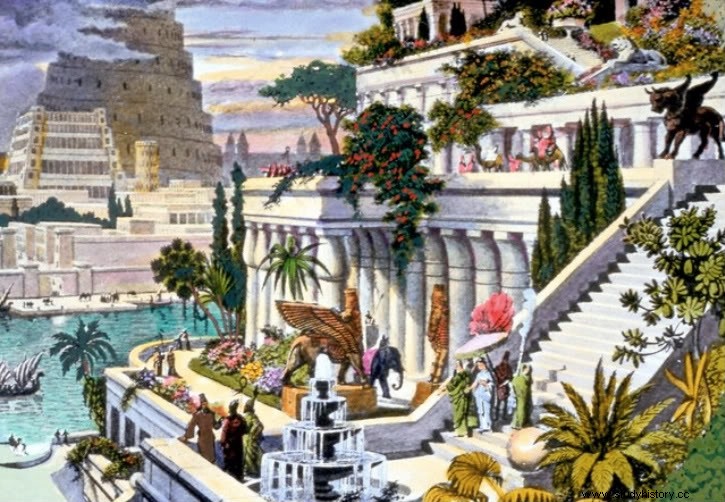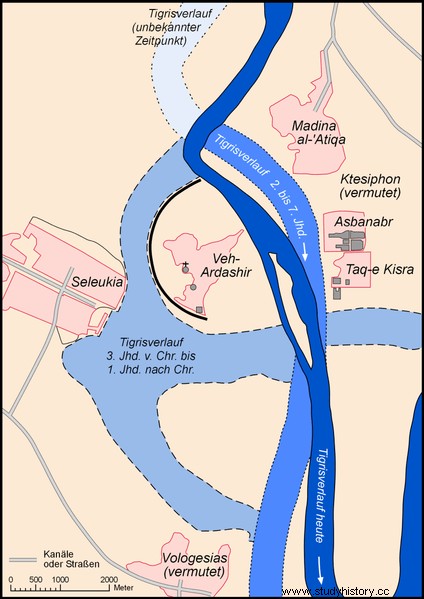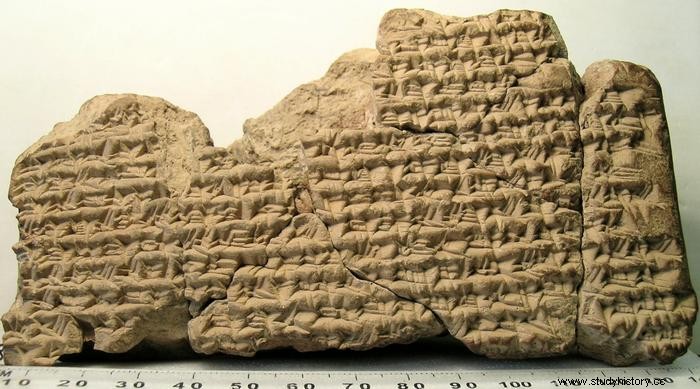When the Persian dynasty of the Achaemenids in the 4 de century BC ruled Mesopotamia or the Land of Two Streams, the civilization between the Tigris and the Euphrates had already come a long way in world history. For millennia, the inhabitants of this region – most of which are located in present-day Iraq – have been regarded as the frontrunners in the evolution of humanity towards an established and developed society. They were the first farmers, the first urban planners, the first writers…

The Babylon of the Western fantasy world with the mythical Hanging Gardens in the foreground and the equally legendary Tower of Babel in the background, on an illustration from the 19th century
The relatively young Greek city-states at the time couldn't help but marvel at the far-reaching past and the age-old traditions of this proud people. Stories of quasi-legendary monarchs such as the Queen Semiramis and rumors of colossal, superhuman building complexes such as the "Hanging Gardens" of Babylon entered the Greek fantasy world. The Mesopotamians also began to learn more and more about the poleis through trade. in the West. However, there was even more to the relationship between these two cultures:they became closely intertwined for more than 200 years. After the arrival of Alexander the Great in 331 B.C. for the Land of Two Streams saw its Persian master leave and a Hellenic took its place. What followed was a period of Greco-Macedonian rule for two centuries.
The arrival of the Hellenes and the battle for Mesopotamia
After Alexander's resounding victory over the Persians near Gaugamela on October 1, 331 BC, the road to Babylonia was open to the Greco-Macedonian troops. The entry of the world conqueror into the region's most important city, the legendary Babylon, was a grandiose occasion, according to Greek sources. To the cheers of the inhabitants, the phalanxes marched without resistance solemnly into a city that only a few years before was only the object of their wildest dreams:
τε οὐ Βαβυλῶνος ἦν καὶ δύναμιν ξυντεταγμένην ὡς ἐς μάχην ἦγε, καὶ οἱ Βαβυλώνιοι πανδημεὶ ἀπήντων αὐτῷ καὶ ἄρχουσι, δῶρά τε ὡς ἕκαστοι φέροντες καὶ τὴν πόλιν ἐνδιδόντες καὶ τὴν τὰ χρήματα. δὲ παρελθὼν εἰς , καθεῖλεν, ἀνοικοδομεῖν προσέταξε Βαβυλωνίοις, τά τε ἄλλα καὶ Βήλου ἱερόν, μάλιστα θεῶν τιμῶσι Βαβυλώνιοι.
“He (Alexander) was already near Babylon and was leading an army prepared for battle, when the Babylonians, together with their priests and rulers, approached him en masse, carrying gifts with them and destroying the city, the fortress and the handed over the treasury. After Alexander arrived in Babylon, he ordered the restoration of the shrines of Xerxes for the Babylonians. had destroyed, especially the temple of Bel, which the Babylonians honor most of all the gods.” (Arrian , Anabasis Alexandri , 3.16.3-4)

The Entry of Alexander into Babylon in the painting of the same name by the French painter Charles Le Brun from the Louvre collection
Alexander had grand plans for Babylon:the city was to become the center of his world empire. However, the Macedonian died at the age of 32 in 323 B.C. before being able to expand its intended capital. The unfortunate consequences of his untimely death are now well known:the king's generals and friends immediately rallied for supremacy over the vast empire. One of the worst hit areas was Mesopotamia. After all, the Two Streams Country was considered one of the richest regions in Western Asia and was therefore indispensable for the ambitious generals with their money-consuming wars. Moreover, because of its central location in Western Asia, Mesopotamia was of great strategic importance. The diadochi who dreamed of conquering Asia could not possibly achieve this without first placing themselves firmly in the saddle of the Two-Stream Land.

Bust of Seleucus I Nicator
This region was primarily the subject of a bloody conflict between Antigonos I Monophthalmos and Seleucus I Nicator that dragged on for years. Under Alexander the Great, Seleucus was the commander of the elite corps of the so-called “Silverds” (Hypaspistai ) and after the Treaty of Triparadeisos (321 B.C.) he obtained governorship of Babylonia. In 316 B.C. the mighty Antigonus drove the young general from his province. This would later in 312 B.C. with a small following and the support of Ptolemy I returned and regained the land between the Tigris and Euphrates. That the inhabitants of this area had a hard time during this conflict is clear from some indigenous sources such as the "Diadochen Chronicle", a damaged clay tablet that speaks of "wailing and mourning in the land". Seleucus eventually emerged victorious and drove Antigonus to the west.
Seleucus consolidates his power:the foundation of Seleucia-on-the-Tigris
Though the wars between the successors continued, after Antigonus' expulsion, peace returned to the land between the Tigris and Euphrates. Seleucus could now focus more on expanding his rule in this area. He crowned himself king in the year 305 BC. and proceeded with an extensive colonization policy that saw the light of numerous Greco-Macedonian settlements throughout Asia. To make clear the power of the new regime, the new towns often bore the name of the monarch or one of his relatives. These foundations primarily served to consolidate Seleucid power in the newly conquered territories.

Archaeological map of Seleucia-on-the-Tigris
The most important city that the new king had built in the Twotrom country was Seleucia (Seleukeia ) on the banks of the Tigris (also called Seleucia-on-the-Tigris). Seleucia would become one of the most prominent cities during the Hellenistic period. The wall of the city would embrace an area of about 550 hectares. Modern estimates put the population at around 100,000 plus a dependent population of 400,000 in the surrounding area, a huge number in the ancient world. Seleucia mainly owed its wealth to its favorable location, namely at the crossroads of two important trade routes. In the first place, the city controlled the lucrative trade that came from Bactria (present-day Afghanistan) and northern Iran via the eastern country road. In addition, the city watched over the influx of goods from India and Arabia via the Persian Gulf.
A popular view of the past was that with the creation of Seleucia the death blow was inflicted on Babylon. The entire population – except for a few priests – is said to have sought new accommodation in the Greek capital. The ancient authors already described how the once magnificent center of Babylonian civilization degenerated into a necropolis through the foundation of Seleucia:
καὶ γὰρ ἐκεῖνος καὶ οἱ μετ᾽ αὐτὸν ἅπαντες περὶ ταύτην ἐσπούδασαν τὴν πόλιν καὶ τὸ βασίλειον ἐνταῦθα μετήνεγκαν:καὶ δὴ καὶ νῦν ἡ μὲν γέγονε Βαβυλῶνος μείζων ἡ δ᾽ ἔρημος ἡ πολλή, ὥστ᾽ ἐπ᾽ αὐτῆς μὴ ἂν ὀκνῆσαί τινα εἰπεῖν ὅπερ ἔφη τις τῶν ἐπὶ τῶν 'ἐρημία μεγάλη 'στὶν ἡ Μεγάλη πόλις.
“He (Seleucus) and all his successors devoted themselves to (the expansion of) Seleucia and moved there to their palace. Indeed, this (Seleucia) is at present greater than Babylon, now so desolate that it would not hesitate to say that what a comedian once said of Megalopolis from Arcadia:"The great city is a great desert." (Strabo , 16.1.5)
However, research on the clay tablets shows that this is not entirely correct. These sources show how Babylon was still a busy city under Seleucid rule. Although she had lost her political importance on the international stage, this in no way meant her ruin. Moreover, throughout the Hellenistic period, Babylon remained the most important religious center of the Two-Stream Land, which even commanded the respect of the Seleucid king.
Mesopotamia in the 3rd century BC

The 'Ptolemy III Chronicle', a cuneiform tablet from the British Museum (BCHP 11 =BM 34428)
After the devastating Diadochi Wars moved to the West in the beginning of the 3 de century BC a relatively peaceful period began in Mesopotamia. This calm lasted for the rest of the century except for two short, violent interludes. First there was the Third Syrian War (246 BC – 241 BC). Although – as the name suggests – this conflict was primarily fought in Syria, the so-called “Ptolemy III Chronicle” (a Mesopotamian cuneiform tablet) informs us that the Ptolemaic armies had penetrated even as far as Babylon. However, the peace treaty that ended the war left the Two-Stream Land in Seleucid hands.
Later, the peace was again disturbed after the accession of Antiochus III. Then in 222 B.C. the satrap of Media (present day Northern Iran), Molon , in revolt against the central authority. This rebel crossed the Zagros Mountains to capture the Two-Stream Land. He would eventually be defeated by the rightful monarch, but the commotion must have been great. This is evident from Polybius dat Seleucia-on-the-Tigris with Molon had cooperated (Q.54 ). Antiochus III however, was lenient towards the inhabitants of the colony and was satisfied with the payment of a relatively small fine for the treason.
Despite these two brief upheavals and possibly another economic crisis in the late 270s and early 260s B.C. the ancient cities of the Mesopotamian civilization flourished. The southern centers in particular were enriched thanks to the intensifying international trade under the Seleucids. This flourishing in the south was especially noticeable in Uruk, where two new large temple complexes arose. Also in the North, some cities such as Mari, Nineveh and Arslan-Tash benefited from the newfound stability under the 'House of Seleucus'. In the Hellenistic period, the economic center of gravity of the country became especially the Diyala region east of the Tigris (in part at the instigation of the foundation of Seleucia-on-the-Tigris). The archaeological research shows how there was fifteen times more buildings there in the Hellenistic period than in the Persian period. Only Ur shows signs of deterioration, but this is primarily due to the change in the course of the Euphrates:the city was separated from the lifeline that guaranteed its wealth.

Map of ancient Mesopotamia with the most important cities
The curtain falls:the end of the Seleucids in Mesopotamia
In the 2 de century BC maintaining central authority in Mesopotamia became increasingly difficult. Not only did more and more generals and governors revolt and dynastic conflict ravage the empire, but an aggressive new enemy loomed from the East:the Parthians. This people had already in c. 250 B.C. in northern Iran founded an independent kingdom in former Seleucid territory, but it was not until the 2 de century before they became a major threat to the dynasty. around 140 B.C. the Parthians began to commit themselves resolutely to the conquest of the Two-Stream Land.

Tetradrachm of Antiochus VII Euergetes Sidetes
During this battle, there was anarchy for a time between the Tigris and the Euphrates. Neither the Parthians nor the Seleucids immediately succeeded in gaining control of the area. Out of this vacuum sprang some ephemeral kingdoms, ruled by former Seleucid officials or local rulers. Over time, however, the Parthians' hold grew stronger. King Antiochus VII Sidetes (138 – 129 BC) made one last attempt to restore Seleucid rule in the Two-Stream Land. His campaign against the Parthians was initially a success, but the monarch proved no match for the coordinated counter-attack of his enemy. He died in 129 BC. during this campaign. With this the curtain had fallen, the Seleucid dynasty had been definitively expelled from Mesopotamia. Thus, the 200-year Greek-Macedonian rule came to an end.
Conclusion
After Alexander's death and a bloody conflict with Antigonus Monophthalmos for years, Seleucus came to power in the Two-Stream Land at the end of the 4
de
century BC His dynasty consolidated its authority through the founding of some important colonies such as Seleucia-on-the-Tigris. This policy did not cause the loss of the native cities. Moreover, archeology shows how most Mesopotamian settlements during the 3
de
century BC started blooming again. In the 2
de
century BC however, things went downhill for the Seleucids in Mesopotamia due to ongoing internal crises. A new enemy from the East took full advantage of this vulnerable situation:the Parthians. The 'House of Seleucus' in the Two-Stream Land proved unable to withstand this northern Iranian kingdom:the Parthians would take over the region and hold sway for more than three centuries. Meanwhile, the once-powerful Seleucid empire fell into a local Syrian kingdom that became the plaything of foreign powers and finally settled in 63 B.C. was conquered by the Roman general Gnaeus Pompeius Magnus .
